There is something mystical and magical about white caterpillars with their soft, and sometimes fuzzy, and hairy bodies. These exceptionally unique creatures go through a fascinating life cycle, reshaping their entire existence through multiple stages of metamorphosis until these creepy-crawlies reemerge as butterflies and moths.
White-marked Tussock Moth Caterpillar: This creepy-crawly can consume the entire leaf, leaving only the large veins behind.
There are several distinct types of white caterpillars, and they all have unique identifying features. Some are white only in a particular stage of their life cycle, while others are white throughout their caterpillar stage. Furthermore, some fuzzy white caterpillars have spines that can sting and cause skin irritation.
However, not all white caterpillars sting. Continue reading to find out!
Types Of White Caterpillars
Like all caterpillars, white caterpillars come from the insect order Lepidoptera. You can find many of these white caterpillars in various regions around the United States. Some have smooth bodies and identifiable markings, whereas others are hairy and have stings.
So, let\’s look at some of these fantastic fuzzy creatures and their life cycles!
RELATED: 30 Types Of Yellow & Black Caterpillars With Pictures And Fun Facts
1. Fall Webworm Moth Caterpillar
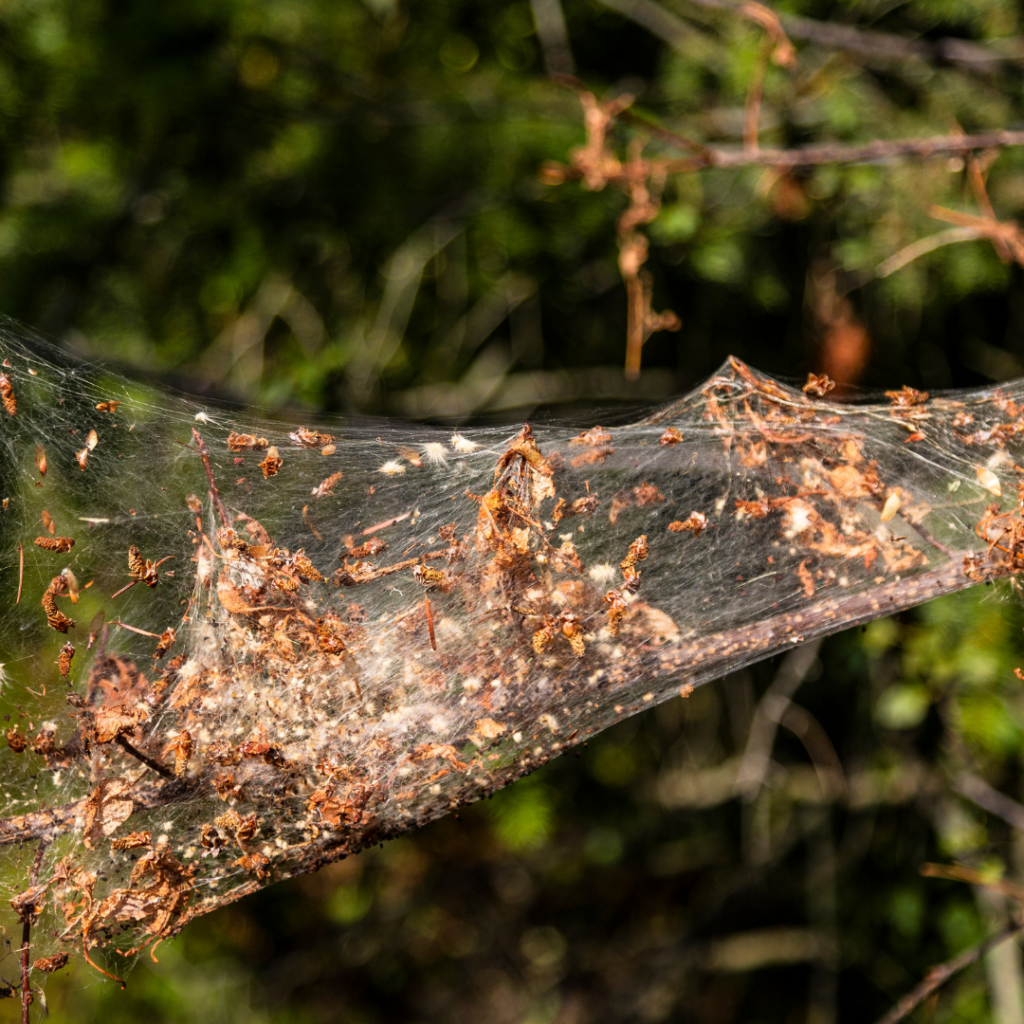
These caterpillars vary highly in coloration, ranging from whitish-gray to pale yellow.
Quick Facts
| Scientific Name | Hyphantria cunea |
| Other Names | The fall webworm, white caterpillar, American webworm |
| Length (cm/inches) | 2.5-4 cm / 1-1.6 inches |
| Width (cm/inches) | 4-5 cm / 1.6-2 inches |
| Habitat/Food Sources | Deciduous trees and shrubs |
| Distribution | Found in North America, Europe, and Asia |
| Dangerous or Not? | Not dangerous, but it can cause aesthetic damage. |
| Pest Status & Damage | Considered a pest due to the defoliation of trees and shrubs. |
Description & Identification Guide
Native to North America, Fall Webworm Moth Caterpillar has become an invasive pest throughout Europe and Asia. Its larvae feed in huge nests and can completely defoliate trees and shrubs. It is a pest of several ornamental trees, shrubs, and crops.
One of their most identifiable features is their behavior. They build communal webs made of silk around the branches of their host plants. These webs can be up to two feet in diameter. Also, they have rows of black or brown spots running along their back.
2. Catalpa Sphinx Moth Caterpillar
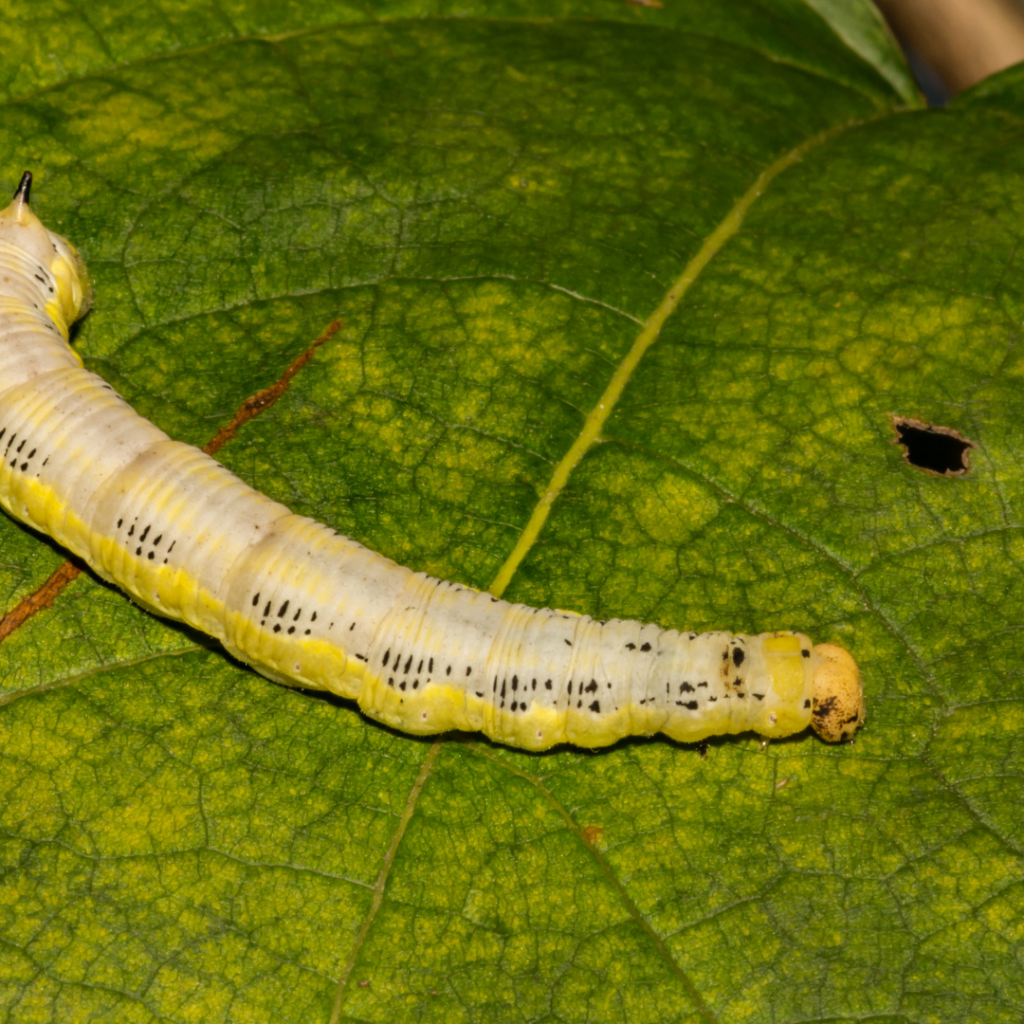
These are the only sphinx moth caterpillars that eat actively in the third and fourth instars.
Quick Facts
| Scientific Name | Ceratomia catalpae |
| Other Names | Catalpa worm, Catawba worm |
| Length (cm/inches) | 8-10 cm / 3-4 inches |
| Width (cm/inches) | 1.5 cm / 0.6 inches (at widest point) |
| Habitat/Food Sources | Catalpa trees |
| Distribution | Found in eastern North America |
| Dangerous or Not? | Not dangerous |
| Pest Status & Damage | Considered a pest due to defoliation of catalpa trees |
Description & Identification Guide
The caterpillar is the larval stage of a native moth in the eastern United States. They only feed on catalpa trees. The Catalpa trees also appear to have a symbiotic relationship with them, as the trees don’t seem to be affected by complete defoliation at times.
Nevertheless, the Catalpa Sphinx Moth Caterpillar can be easily identified by its unique physical characteristics. These caterpillars have long, whitish bodies with several black spots, shiny black heads, and a distinctive horn at the rear end of their body.
3. Virginia Ctenucha Moth Caterpillar
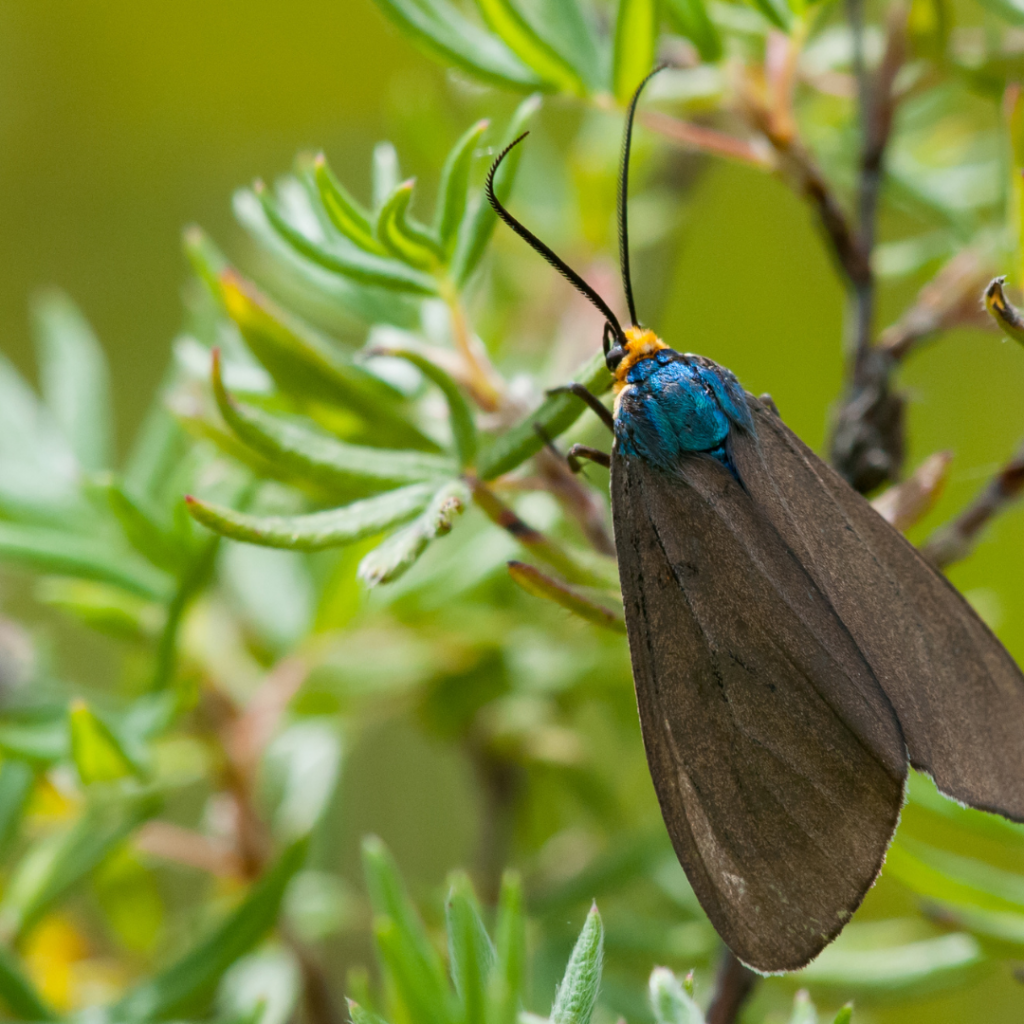
Even though it looks like it could be dangerous, Virginia Ctenucha Moth Caterpillar is harmless.
Quick Facts
| Scientific Name | Ctenucha virginica |
| Other Names | Virginia ctenucha |
| Length (cm/inches) | 3.5-5 cm / 1.4-2 inches |
| Width (cm/inches) | 1-2 cm (0.4-0.8 inches) |
| Habitat/Food Sources | Meadows, fields, and forest edges; feed on grasses and sedges |
| Distribution | Found in eastern and central North America |
| Dangerous or Not? | Not dangerous |
| Pest Status & Damage | Not considered a significant pest |
Description & Identification Guide
The Virginia Ctenuchamoth caterpillar is an attractive creature that might make you pick it up and hug it. However, these caterpillars protect themselves when approached by curling up into a ball, revealing a black streak on their backside.
Furthermore, they are primarily active during the day and can often be seen resting on the plants they feed on. They also have a distinctive reddish head capsule and feet, and you can see black stripes and tufts of long black hair protruding from their body.
4. Hieroglyphic Moth Caterpillar
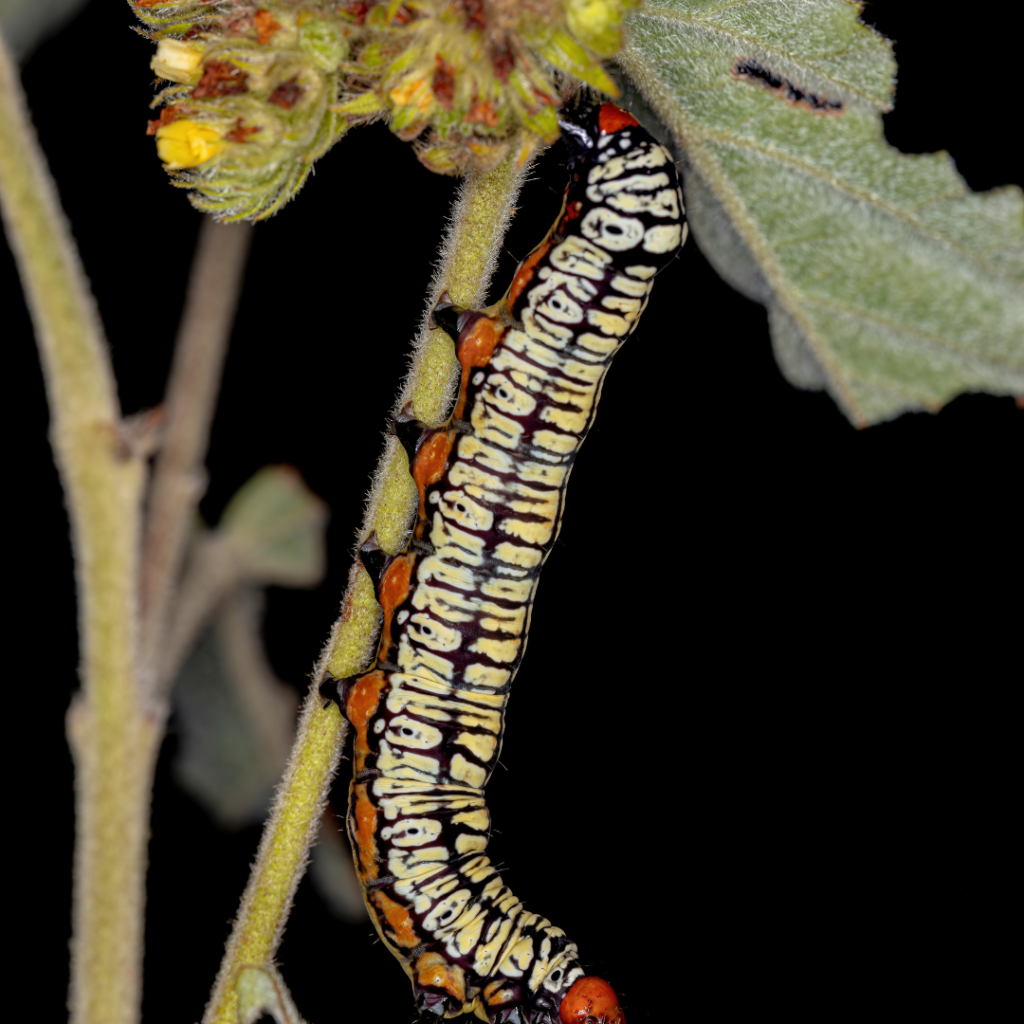
These caterpillars are boldly patterned, warning their predators that they taste bad.
Quick Facts
| Scientific Name | Diphthera festiva |
| Other Names | Hieroglyphic looper |
| Length (cm/inches) | 3-4 cm / 1.2-1.6 inches |
| Width (cm/inches) | 2-3 cm (0.8-1.2 inches) |
| Habitat/Food Sources | Forests and woodlands; feed on the leaves of deciduous trees |
| Distribution | Found in eastern North America |
| Dangerous or Not? | Not dangerous |
| Pest Status & Damage | Considered a minor pest due to occasional defoliation of trees |
Description & Identification Guide
These boldly colored caterpillars can often be seen on a wide range of plant species and sometimes are considered pests of sweet potatoes, pecan, coconut palms, and soybeans. They feed at night, resting in a crevice or the soil of their food plant during the day.
Their distinguishing features include distinctive black and white markings on their head and legs, resembling ancient Egyptian hieroglyphics. Furthermore, their antennae, legs, and abdomen are all glossy black, giving them a bold and classy appearance.
5. Mullein Moth Caterpillar
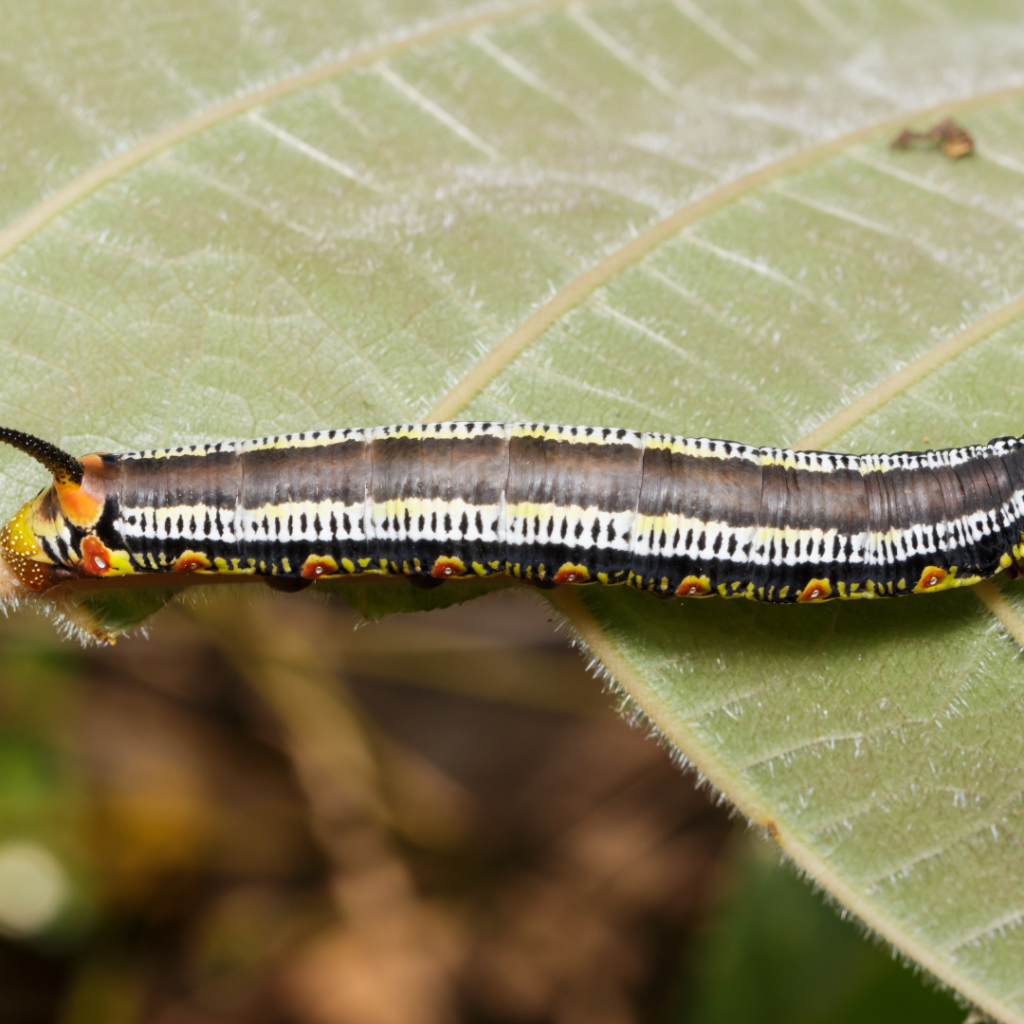
The caterpillars are generally visible from May to July and turn grey before hatching.
Quick Facts
| Scientific Name | Cucullia verbasci |
| Other Names | Mullein caterpillar, Verbascum caterpillar |
| Length (cm/inches) | 5-7 cm / 2-2.8 inches |
| Width (cm/inches) | Mullein Moth Caterpillar |
| Habitat/Food Sources | Meadows, fields, and gardens; feed on leaves of mullein and other plants in the figwort family |
| Distribution | Found in North America and Europe |
| Dangerous or Not? | Not dangerous |
| Pest Status & Damage | Considered a pest due to the defoliation of plants in the figwort family |
Description & Identification Guide
The white, yellow, and black caterpillars of Mullein moths are among the most distinctive white caterpillars you will see on this list. They are easier to spot, as they feed out in the open, both during the day and at night. You will also more likely see the caterpillar than the moth as they crawl across the leaves and can be picked off by hand.
Nevertheless, they can be easily identified by their rounded white bodies with many small black dots and bright yellow patches. If you spot one of these caterpillars in the wild, you can also identify them with their five pairs of prolegs near the body\’s end.
6. Domestic Silk Moth Caterpillar
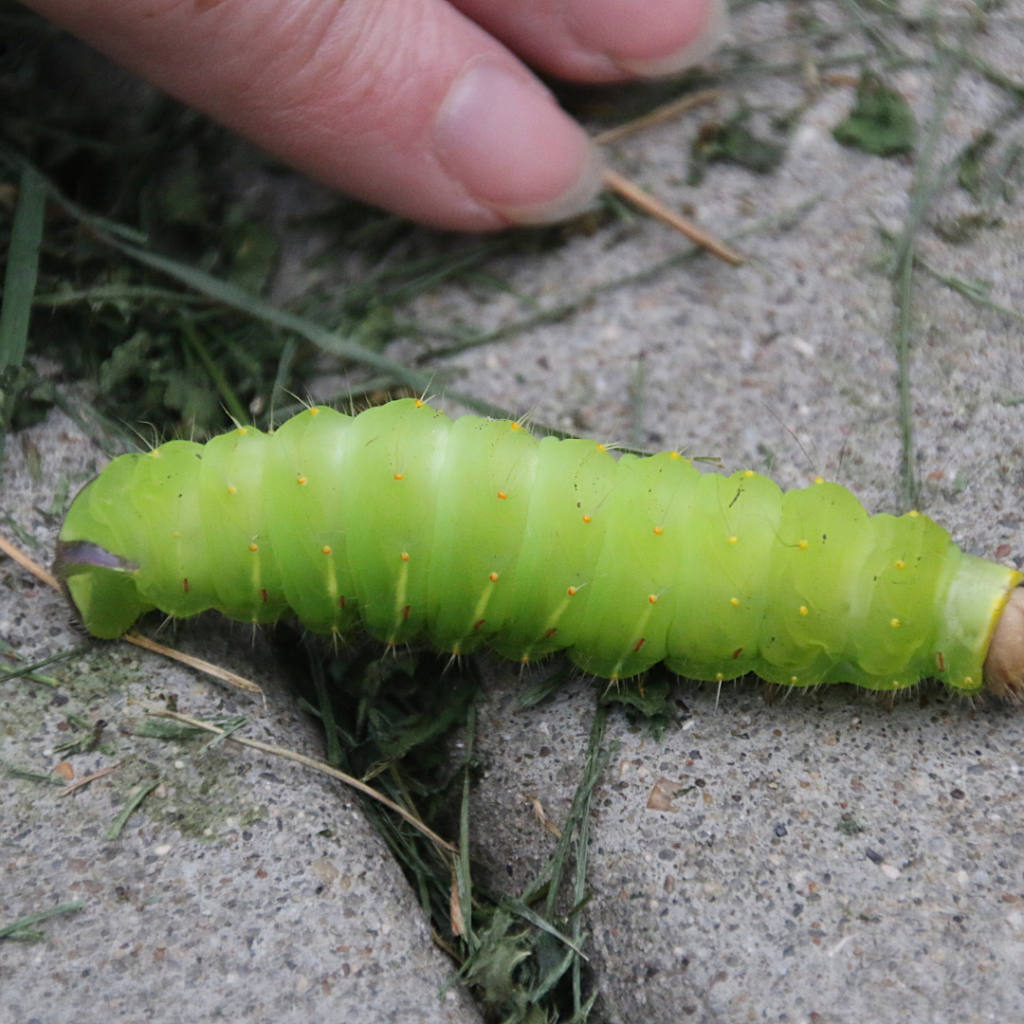
The silkworm is the larva or caterpillar of a silk moth, an economically important insect for silk production.
Quick Facts
| Scientific Name | Bombyx mori |
| Other Names | Domesticated silk moth, silkworm |
| Length (cm/inches) | 5-6 cm / 2-2.4 inches |
| Width (cm/inches) | 3-4 cm (1.2-1.6 inches) |
| Habitat/Food Sources | Domesticated; feed on the leaves of mulberry trees |
| Distribution | Domesticated worldwide |
| Dangerous or Not? | Not dangerous |
| Pest Status & Damage | They are not considered a pest, as they are raised for the production of silk |
Description & Identification Guide
There are over 500 types of silkworms. Still, only a few are used to produce silk, and Bombyx mori is one of them. They feed solely on the leaves of mulberry trees and produce a fine fiber used to make commercial silk. If the caterpillar is allowed to live after spinning its cocoon, it digests that cocoon with enzymes and emerges as an adult moth.
These caterpillars have a pale yellowish-white color with a few scattered black spots on its body. Furthermore, they have three pairs of true legs near the head and five pairs of false legs or prolegs with suction cups near the body\’s end.
7. Little Metalmark Caterpillar
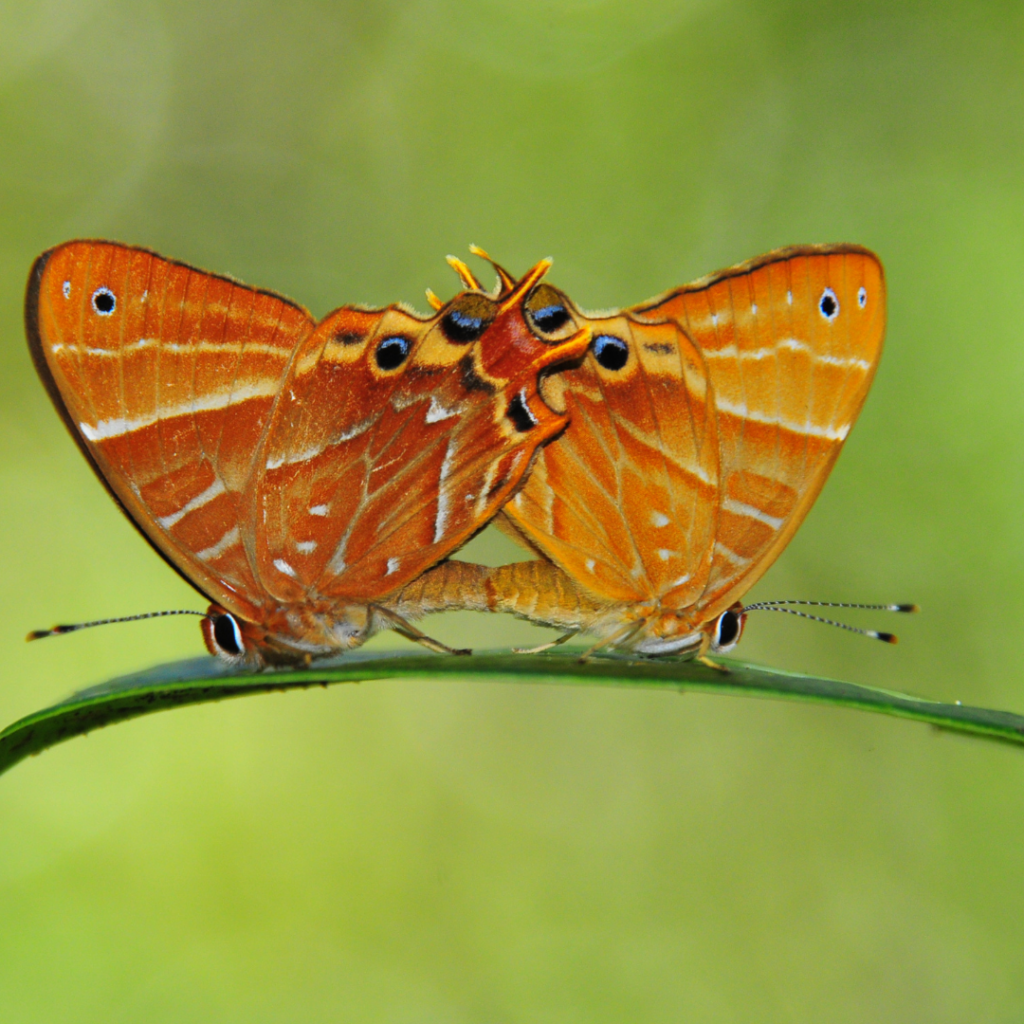
Even though they appear green if you look closely, they are stippled with many tiny white dots.
Quick Facts
| Scientific Name | Calephelis virginiensis |
| Other Names | Little metalmark butterfly larva |
| Length (cm/inches) | 1 cm / 0.4 inches |
| Width (cm/inches) | 0.5-1 cm (0.2-0.4 inches) |
| Habitat/Food Sources | Prairies, savannas, and grassy habitats; feed on the leaves of legumes |
| Distribution | Found in eastern and central North America |
| Dangerous or Not? | Not dangerous |
| Pest Status & Damage | They are not considered a pest, as they do not cause significant damage |
Description & Identification Guide
These caterpillars are present in the US from March through November, with up to five broods in a single year. Older caterpillars of this species chew a distinctive windowpane pattern in host leaves, and they are whitish-green, stippled with many tiny white dots.
The Little Metalmark Caterpillar is active during the day, and you can easily recognize it with its cylindrical body covered in fine, silky hairs that give them a fuzzy appearance. Also, when threatened, it curls up into a tight ball, using its spiky hairs for protection.
RELATED: Types Of Green Caterpillars With Fun Facts, Stunning Pictures And Loads More!!!
8. Planthopper Parasite Moth Caterpillar

Unlike most other caterpillars that munch on leaves, these caterpillars gnaw on the flanks of cicadas.
Quick Facts
| Scientific Name | Fulgoraecia exigua |
| Other Names | Planthopper Parasite Moth Caterpillar |
| Length (cm/inches) | 1.2-1.5 cm / 0.5-0.6 inches |
| Width (cm/inches) | 2.2-2.5 cm / 0.9-1 inch |
| Habitat/Food Sources | Found in grasslands and open areas. Larvae feed on planthoppers |
| Distribution | Found in Asia, including India, Thailand, and Vietnam |
| Dangerous or Not? | Not dangerous |
| Pest Status & Damage | Not considered a pest, as it is a natural predator of planthoppers. |
Description & Identification Guide
These caterpillars resemble the woolly bugs from The Ancient Magus\’ Bride. When young, they look like ordinary grubs. However, they become covered with a fuzzy white coat of wax when they reach their final instar (the life stage just before changing into a pupa).
Furthermore, they have three pairs of true legs near the head and several false legs or prolegs. Also, a series of black spots and stripes run the length of their bodies. They can be seen on various plants, waiting for the planthopper to come close enough to attack.
9. Laugher Caterpillar

The laugher caterpillar gets its name from its moth, which looks like a laughing man on its folded wings.
Quick Facts
| Scientific Name | Lophocampa maculata |
| Other Names | Marbled prominent caterpillar, marbled tuffet caterpillar |
| Length (cm/inches) | 3-4 cm / 1.2-1.6 inches |
| Width (cm/inches) | 2-3 cm (0.8-1.2 inches) |
| Habitat/Food Sources | Feed & live on deciduous trees such as oak, maple, and birch |
| Distribution | Found throughout North America |
| Dangerous or Not? | Can cause skin irritation if touched, as they have urticating hairs |
| Pest Status & Damage | They are considered a pest in some areas. |
Description & Identification Guide
There is usually only one generation of these caterpillars annually in the northern US (two at most). They feed on the older, hardened leaves of oaks, birches, maples, elms, and other broadleaf trees that are usually too tough for other caterpillar species to consume.
These peculiar caterpillars have wispy long white hairs and squishy white bodies. However, the unique black-and-white patterns on their head set them apart from other caterpillars. In the final stage, their head becomes mostly black with creamy stripes before pupating.
10. Spotted Apatelodes Caterpillar
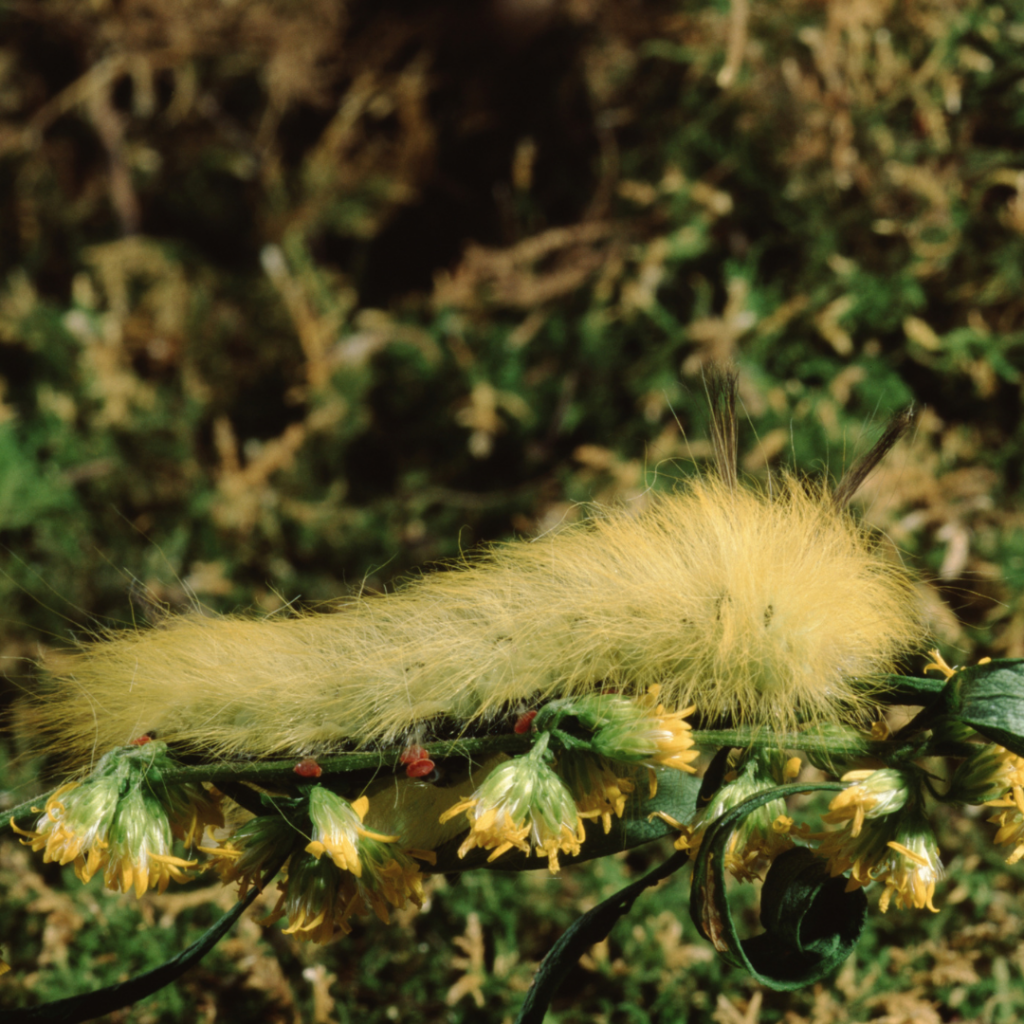
Spotted Apatelodes Caterpillar has white, neon hair that becomes bright yellow as it matures.
Quick Facts
| Scientific Name | Apatelodes torrefacta |
| Other Names | Spotted Apatelodes Caterpillar, Spiny Oakworm |
| Length (cm/inches) | 6-8 cm / 2.4-3.1 inches |
| Width (cm/inches) | Spotted Apatelodes Caterpillar |
| Habitat/Food Sources | Feed & live on the leaves of trees such as oak, hickory, and walnut |
| Distribution | Found in eastern North America |
| Dangerous or Not? | Can cause skin irritation if touched, as they have spiny hairs |
| Pest Status & Damage | Considered a pest in some regions. |
Description & Identification Guide
These caterpillars have red feet and legs, contrasting nicely with their white furry bodies. They also have short black spikes along their segments and long black lashes hanging behind their heads. As the caterpillars mature, the hairs turn into a dazzling neon yellow.
The head of the Spotted Apatelodes Caterpillar is small and black. Furthermore, it has distinctive yellow spots running the length of its body, which give it its name. Once it reaches its final instar, the caterpillar pupates on the ground, transforming into an adult moth.
11. Dalceridae Moth Caterpillar
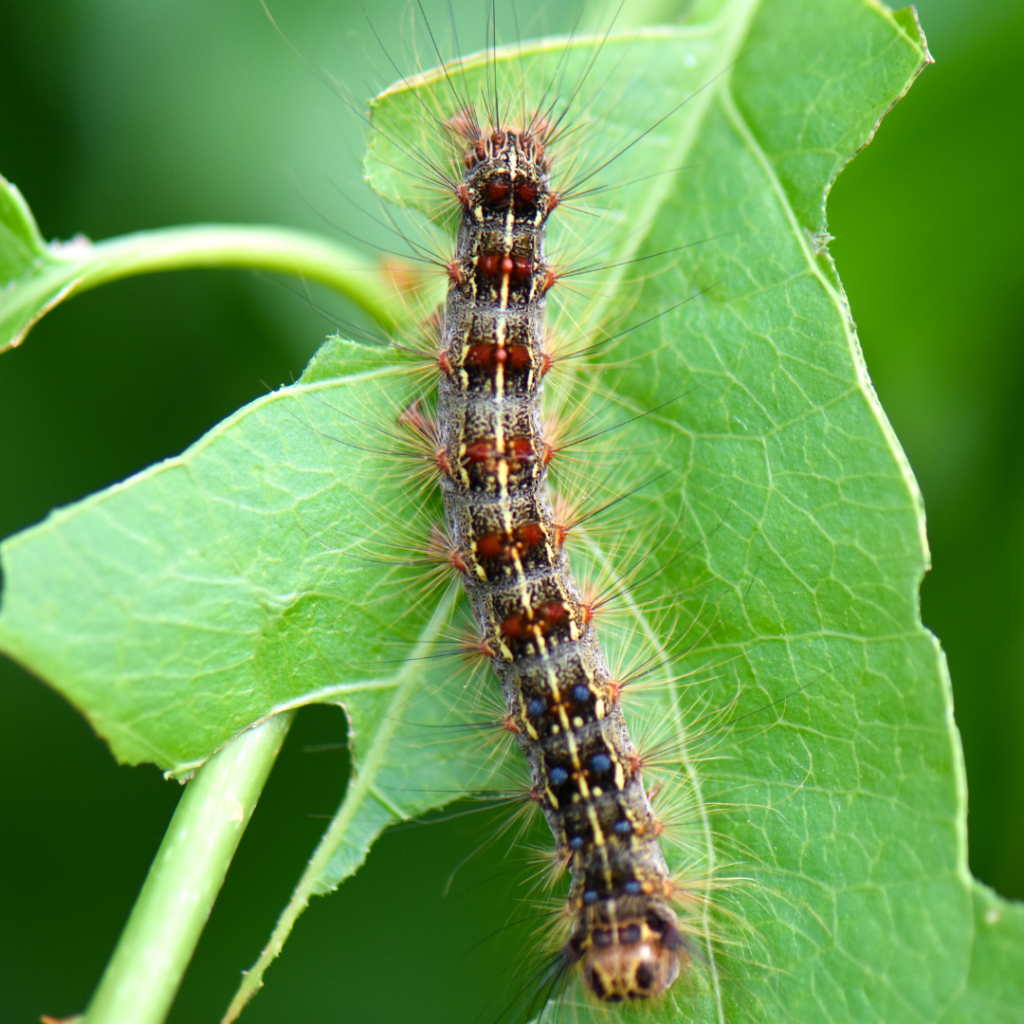
The translucent Dalceridae Moth Caterpillar looks more tasty, gummy, and sweet than a moth larva.
Quick Facts
| Scientific Name | Acraga coa |
| Other Names | Jewel caterpillar |
| Length (cm/inches) | Up to 2 cm / 0.8 inches |
| Width (cm/inches) | N/A |
| Habitat/Food Sources | Found in rainforests; feed on lichens |
| Distribution | Found in parts of Central and South America |
| Dangerous or Not? | Not known to be dangerous to humans or animals. |
| Pest Status & Damage | They are not considered a pest, as their feeding does not harm plants. |
Description & Identification Guide
Dalceridae moth caterpillars remind me of nudibranchs, strikingly colored mollusks that can be best described as \”trippy.\” These caterpillars are creatures of such beauty that you might just want to hang them around your neck. Nevertheless, they are sticky for a reason.
Their stickiness protects them from becoming the food of hungry insects such as ants.
Some people think they look more like slugs, so they are often called \”slug caterpillars\” as well. Nevertheless, if you ever observe one of these caterpillars in the wild, take a moment to appreciate its delicate beauty and the vital role it plays in its environment.
12. American Dagger Moth Caterpillar
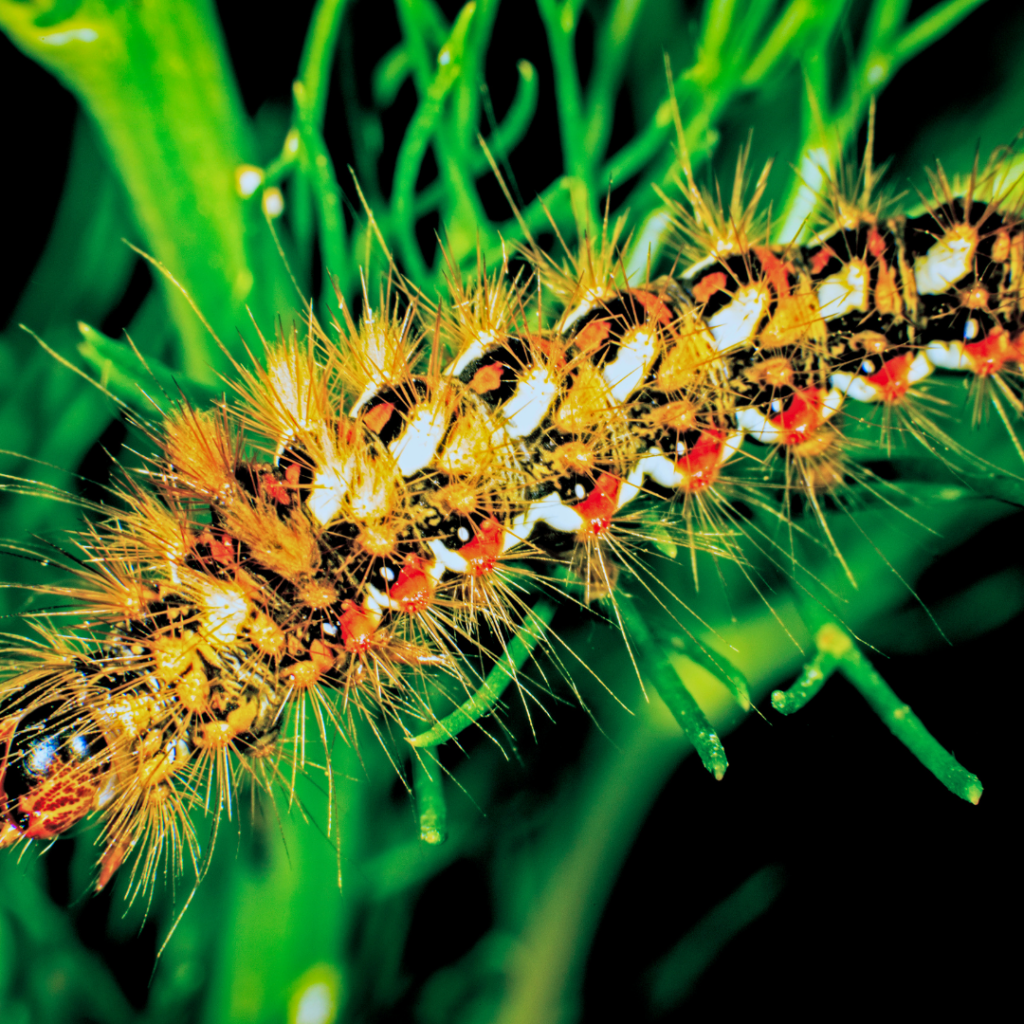
The American dagger moth caterpillar is not venomous, but its fine hair can still cause skin irritation.
Quick Facts
| Scientific Name | Acronicta americana |
| Other Names | American dagger moth caterpillar, hairy caterpillar |
| Length (cm/inches) | 4-5 cm / 1.5-2 inches |
| Width (cm/inches) | 2-3 cm (0.8-1.2 inches) |
| Habitat/Food Sources | Feed on the leaves of trees such as birch, oak, and maple |
| Distribution | Found throughout eastern North America |
| Dangerous or Not? | Can cause skin irritation if touched, as they have spiny hairs. |
| Pest Status & Damage | Their feeding can defoliate trees and impact forest health |
Description & Identification Guide
The Dagger Moth Caterpillar has a unique way of defending itself. When it feels threatened, it will roll into a tight little ball, and its hair will stand, making it look like a miniature porcupine. However, despite looking spiky, you can notice that their hair is oddly silky to the touch.
Nevertheless, if you look closely, you will see that the Dagger Moth Caterpillar has a tiny black nose that is just adorable. It\’s so small that you could easily miss it. The nose is surrounded by two black eyes that will seem to stare directly into your soul.
13. Virginian Tiger Moth Caterpillar
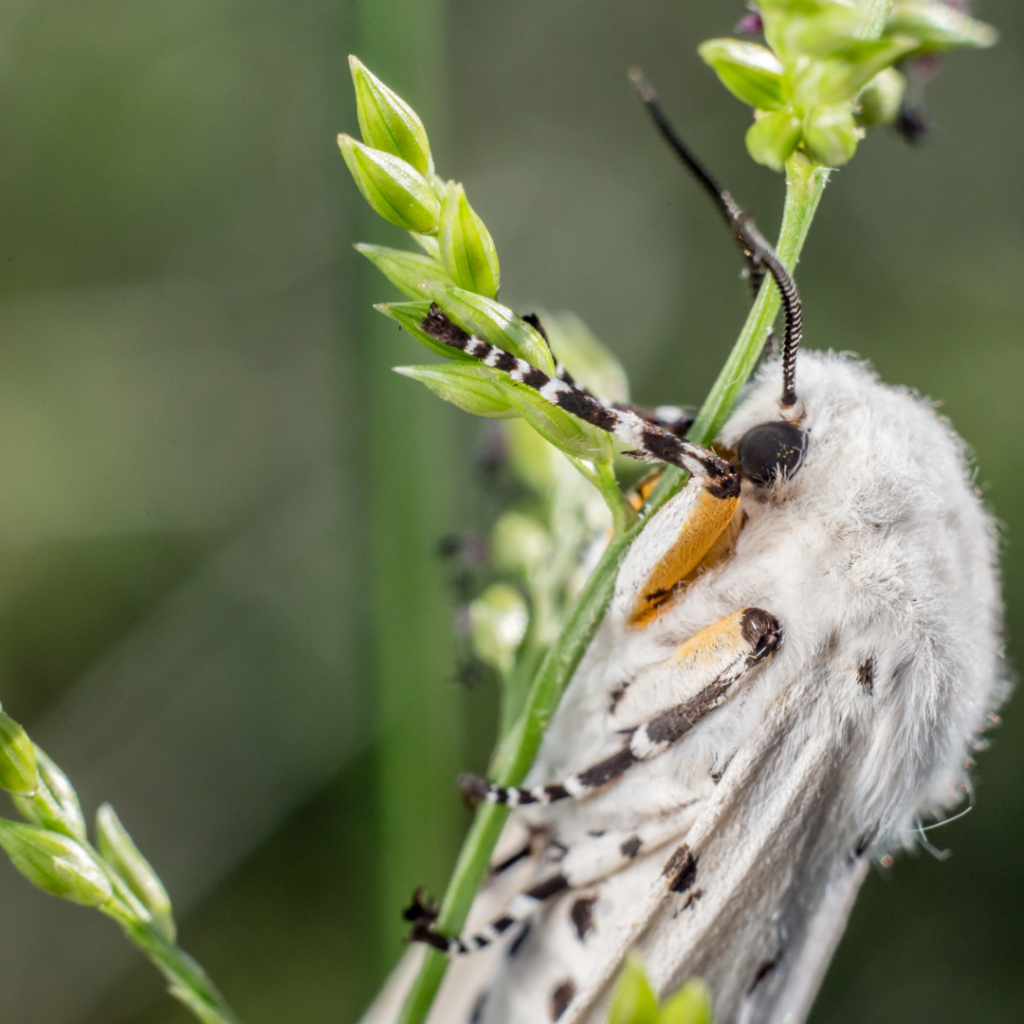
On average, the Virginian Tiger moth caterpillar lives for about ten days unless they overwinter.
Quick Facts
| Scientific Name | Spilosoma virginica |
| Other Names | Virginian tiger moth caterpillar, woolly bear caterpillar |
| Length (cm/inches) | Up to 5 cm / 2 inches |
| Width (cm/inches) | 1.5-2 cm (0.6-0.8 inches) |
| Habitat/Food Sources | Found in various habitats, including fields, meadows, and gardens. |
| Distribution | Found throughout eastern North America, from Canada to Mexico |
| Dangerous or Not? | Not known to be dangerous to humans or animals. |
| Pest Status & Damage | Not considered a pest |
Description & Identification Guide
These caterpillars show sexual dimorphism, with females slightly larger than males. Nevertheless, these caterpillars have a hairy appearance, primarily yellow and white, and sometimes they are also sparsely covered in tufts of black hairs.
Once they reach their full size, they will burrow underground to overwinter and emerge as the Virginian Tiger Moth. You can also identify them with their unique feeding habit. They \”skeletonize\” leaves and eat all leaf tissue except the large veins.
14. Sycamore Tussock Moth Caterpillar
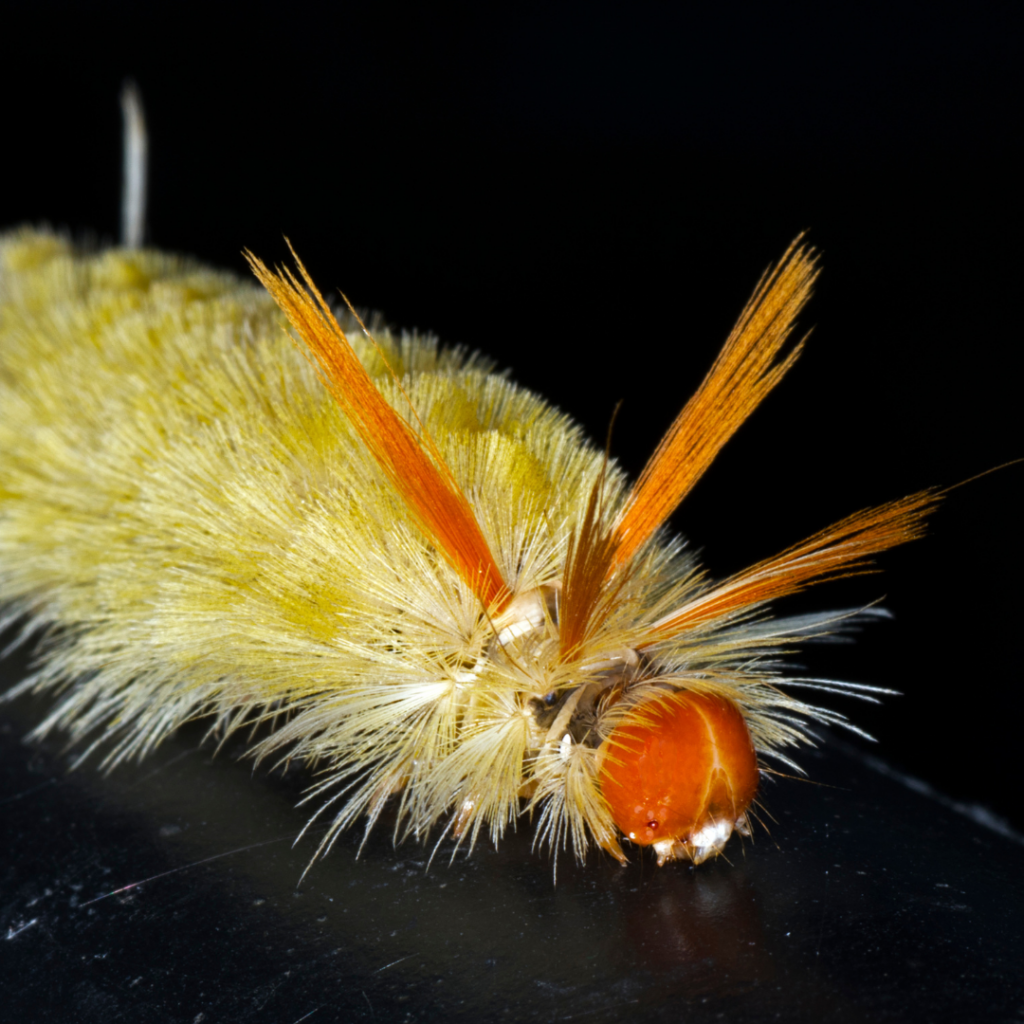
These caterpillars have yellow-orange heads and bodies covered with fluffy white hair.
Quick Facts
| Scientific Name | Halysidota harrisii |
| Other Names | Sycamore tussock moth caterpillar, white-marked tussock moth caterpillar |
| Length (cm/inches) | Up to 4 cm / 1.5 inches |
| Width (cm/inches) | 2-3 cm (0.8-1.2 inches) |
| Habitat/Food Sources | Feed on the leaves of trees such as sycamore, maple, and oak |
| Distribution | Found throughout eastern North America |
| Dangerous or Not? | Can cause skin irritation if touched, as they have spiny hairs |
| Pest Status & Damage | Considered a pest in some areas. |
Description & Identification Guide
Although these caterpillars do not sting, you should not handle them as their hairs can cause skin irritation, itching, and rashes. And other than their hair, these caterpillars have additional two to four pencil-like orange chunks of hair near their head. Furthermore, the caterpillar also has two long pencil-like hairs protruding from both ends of its body.
Nevertheless, the fully grown, hairy caterpillars are usually seen in late summer and early Autumn when they are about to pupate. They pupate in late June and July and emerge as Sycamore Tussock Moths in July and August.
15. Hickory Tussock Moth Caterpillar
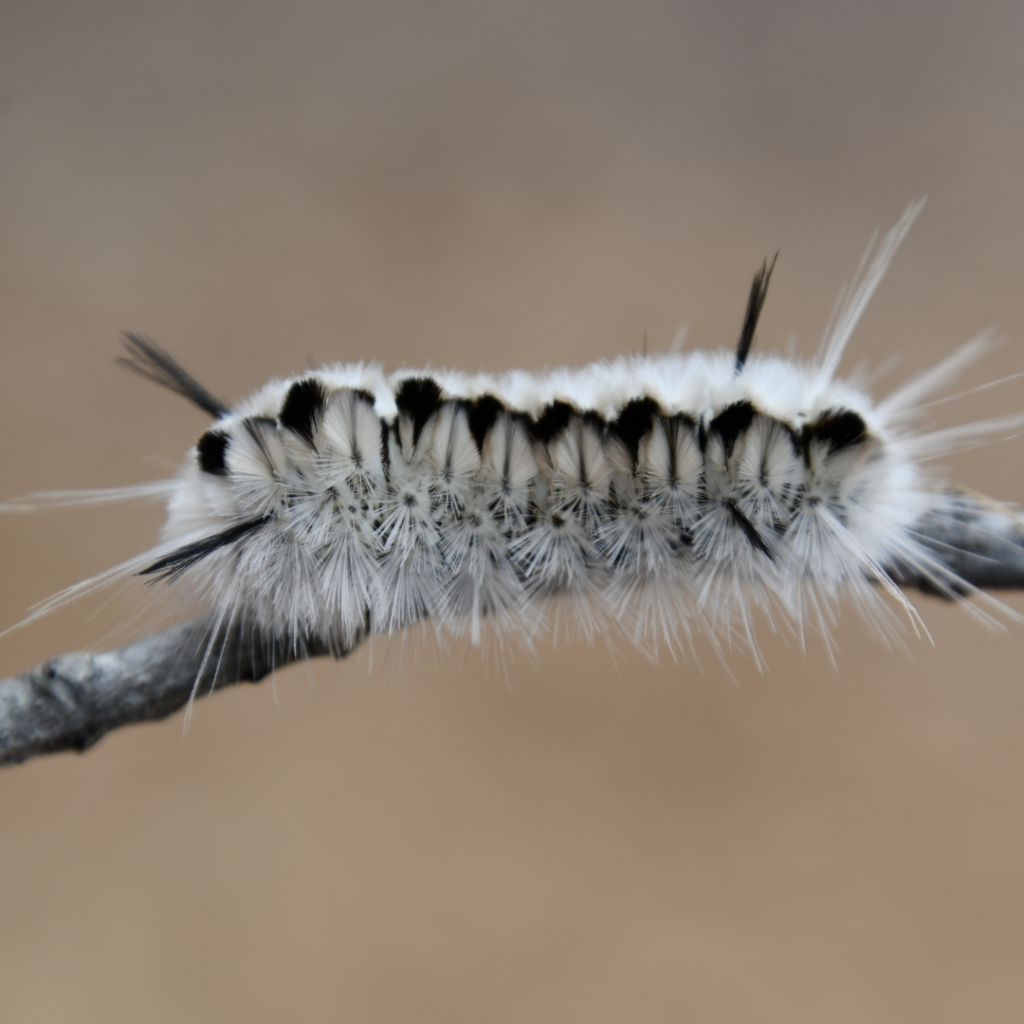
Hickory tussock moth caterpillars have one generation per year and are commonly encountered in the fall.
Quick Facts
| Scientific Name | Lophocampa caryae |
| Other Names | Hickory tussock moth caterpillar |
| Length (cm/inches) | Up to 4 cm / 1.5 inches |
| Width (cm/inches) | 1.5-2 cm (0.6-0.8 inches) |
| Habitat/Food Sources | Found in deciduous forests |
| Distribution | Found throughout eastern North America |
| Dangerous or Not? | It can cause skin irritation if touched, as they have spiny hairs |
| Pest Status & Damage | It is considered a pest in some places. |
Description & Identification Guide
Hickory tussock moth caterpillars are fuzzy, white creatures often appearing in the fall. Their hairs can irritate the skin, but there are no known cases of allergic reactions. Nevertheless, they feed on hardwood trees, including hickory, walnut, hornbeam, elm, and willow. However, their preferred hosts are birch, aspen, and black locust.
If you look closely, you can also see long black hairs sticking out from areas near the front and back of the caterpillar. The caterpillars eventually turn into rusty-brown moths.
16. White-marked Tussock Moth Caterpillar
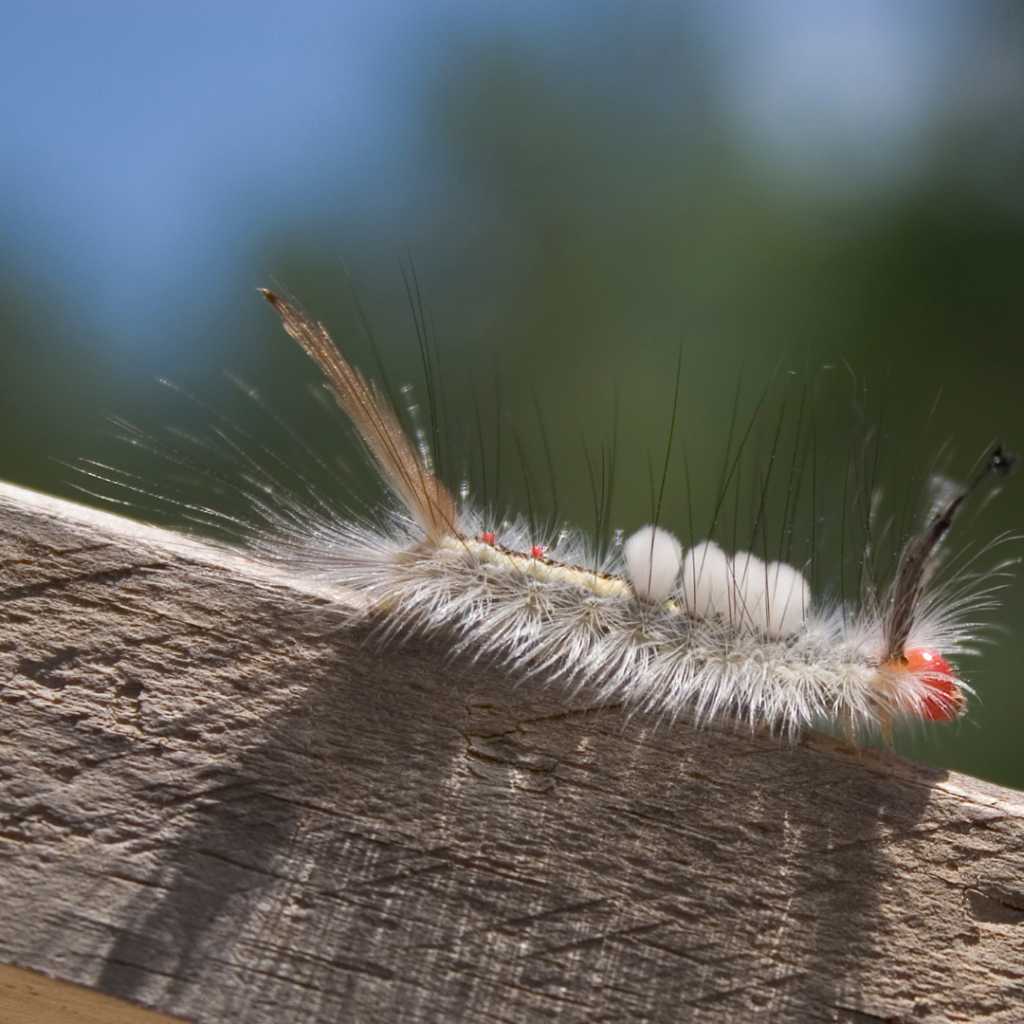
These caterpillars can skeletonize entire leaves, while older larvae eat everything except the prominent veins.
Quick Facts
| Scientific Name | Orgyia leucostigma |
| Other Names | White-marked tussock moth caterpillar |
| Length (cm/inches) | Up to 4 cm / 1.5 inches |
| Width (cm/inches) | 2-3 cm (0.8-1.2 inches) |
| Habitat/Food Sources | Found in a variety of habitats, including forests, fields, and gardens |
| Distribution | Found throughout North America, from Canada to Mexico |
| Dangerous or Not? | Can cause skin irritation if touched, as they have spiny hairs. |
| Pest Status & Damage | They can cause a nuisance by dropping from trees onto cars and pedestrians. |
Description & Identification Guide
These distinctive-looking caterpillars are known to feed on plants belonging to 116 genera. And trees under stress or newly planted suffer the most damage. After feeding for several weeks, they spin grayish cocoons, inside of which they pupate and emerge as moths.
Nevertheless, you can quickly identify them with the two hair \”pencils\” of black setae extending beyond the head. Furthermore, they have four brush-like tufts or bunches of light tan white hairs on the back, giving them their odd (White-marked) name.
17. Fall Webworm Caterpillar
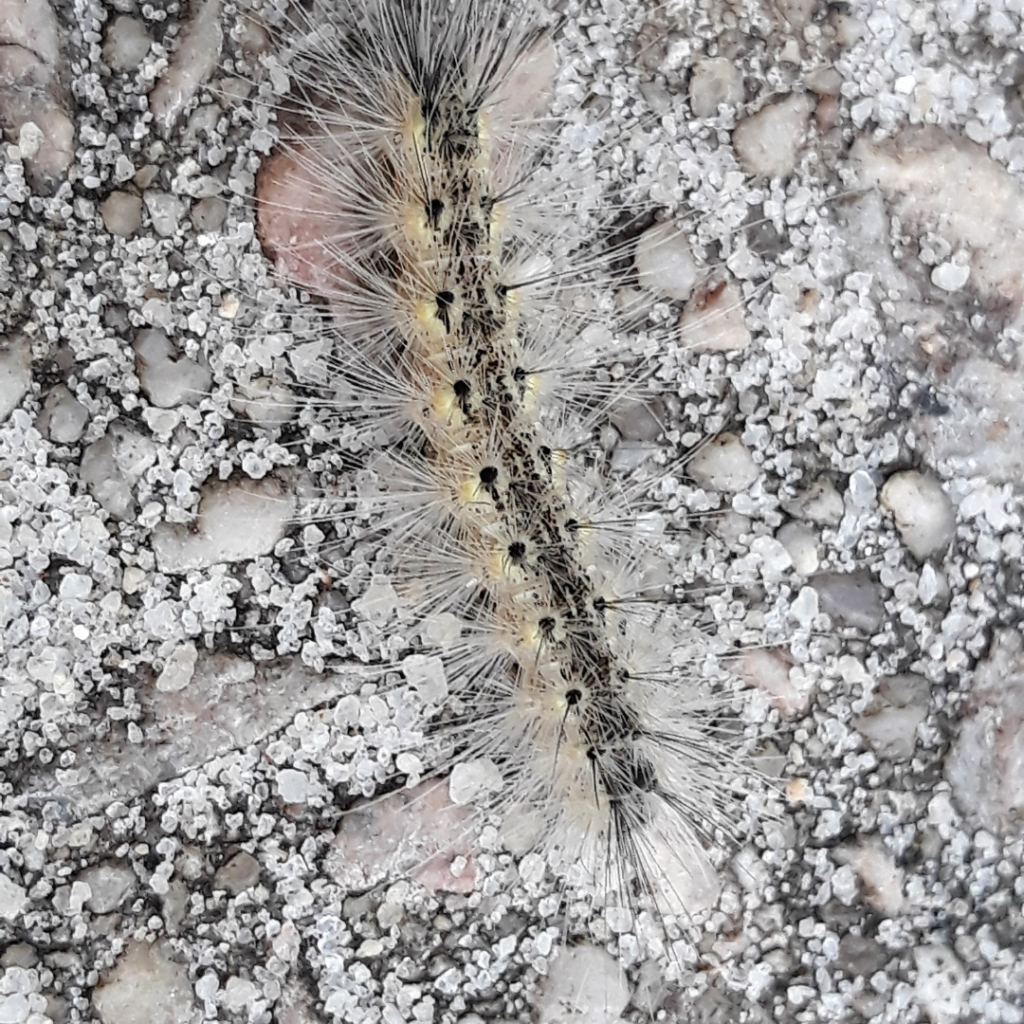
These caterpillars overwinter in giant silk cocoons and transform into an adult in the spring.
Quick Facts
| Scientific Name | Hyphantria cunea |
| Other Names | Fall webworm caterpillar |
| Length (cm/inches) | Up to 4 cm / 1.5 inches |
| Width (cm/inches) | 2-4 cm (0.8-1.6 inches) |
| Habitat/Food Sources | Found in a variety of habitats |
| Distribution | Found throughout North America, from Canada to Mexico |
| Dangerous or Not? | Not dangerous |
| Pest Status & Damage | Considered pest |
Description & Identification Guide
These caterpillars have pale yellow or white bodies with a few black spots on the back. You can also see long tufts of silky grey hairs emerge from their bodies. There are also two types of these caterpillars: the red-headed fall webworm caterpillar and the black-headed.
The red-headed are tan and emerge from a double layer of eggs. In contrast, the black-headed caterpillars have a lighter body color and arise from a single layer of eggs.
RELATED: How To Get Rid Of Sweat Bees Quickly & Easily? Simple Ways That Work
18. Figwort Sawfly Caterpillar
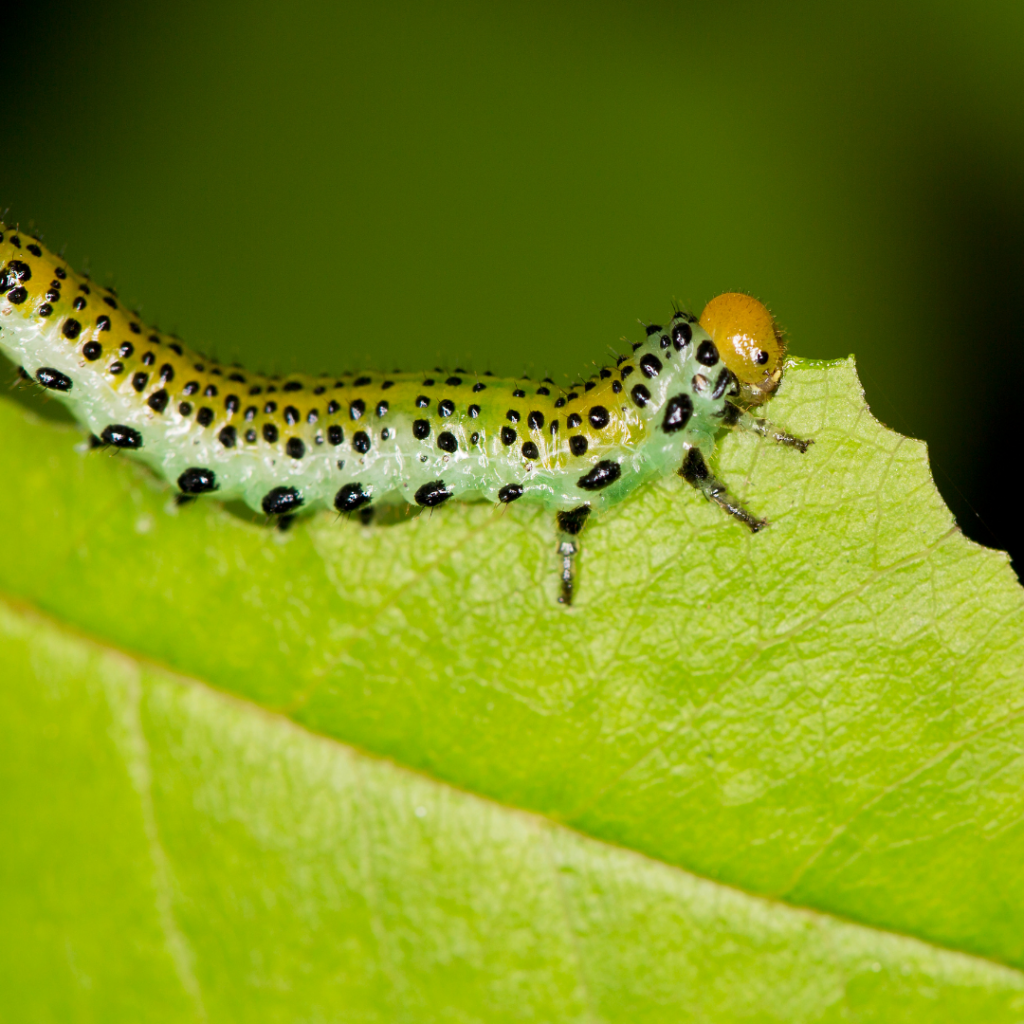
These caterpillars feed on Figwort plants and are typically seen in August and September.
Quick Facts
| Scientific Name | Endelomyia aethiops |
| Other Names | Figwort sawfly caterpillar |
| Length (cm/inches) | Up to 2.5 cm / 1-inch |
| Width (cm/inches) | 1 cm (0.4 inches) |
| Habitat/Food Sources | Found on figwort and snapdragon plants |
| Distribution | Found in Europe and North America |
| Dangerous or Not? | Not dangerous to humans or animals. |
| Pest Status & Damage | They can cause the defoliation of figwort and snapdragon plants |
Description & Identification Guide
These large white and black-dotted caterpillars turn into Figwort sawflies. The Figwort sawfly wasp hunts white. In contrast, the caterpillar itself eats plants of the Figwort family. You can quickly identify them by counting their legs; however, it could be problematic in tiny larvae.
Nevertheless, they have three true legs at the front but have more \’stumpy\’ prolegs, five or more, near the abdomen. Lastly, the caterpillar also has a crinkled appearance.
19. Black-Waved Flannel Moth Caterpillar

Even though these caterpillars look like they welcome touch, you must resist the temptation.
Quick Facts
| Scientific Name | Lagoa crispata |
| Other Names | Black-waved flannel moth caterpillar |
| Length (cm/inches) | Up to 3.8 cm / 1.5 inches |
| Width (cm/inches) | 2-3 cm (0.8-1.2 inches) |
| Habitat/Food Sources | Found in tropical and subtropical regions on a variety of host plants |
| Distribution | Found in parts of Central and South America, as well as the Caribbean |
| Dangerous or Not? | They can cause painful stings and allergic reactions if touched. |
| Pest Status & Damage | They can defoliate trees and impact crop yields |
Description & Identification Guide
These caterpillars are called Black-waved Flannel Moth caterpillars because when they mature into a moth, the moth has lines of black crimped hairs on creamy wings. These caterpillars differ from the caterpillars of all other butterflies and moths by their number of prolegs. They have seven prolegs, while all other caterpillars have five or fewer pairs.
And as already said, these caterpillars can sting. Reactions to the stings vary depending on the life stage of the caterpillar and a person’s sensitivity to the sting.
20. Edwards’ Wasp Moth Caterpillar
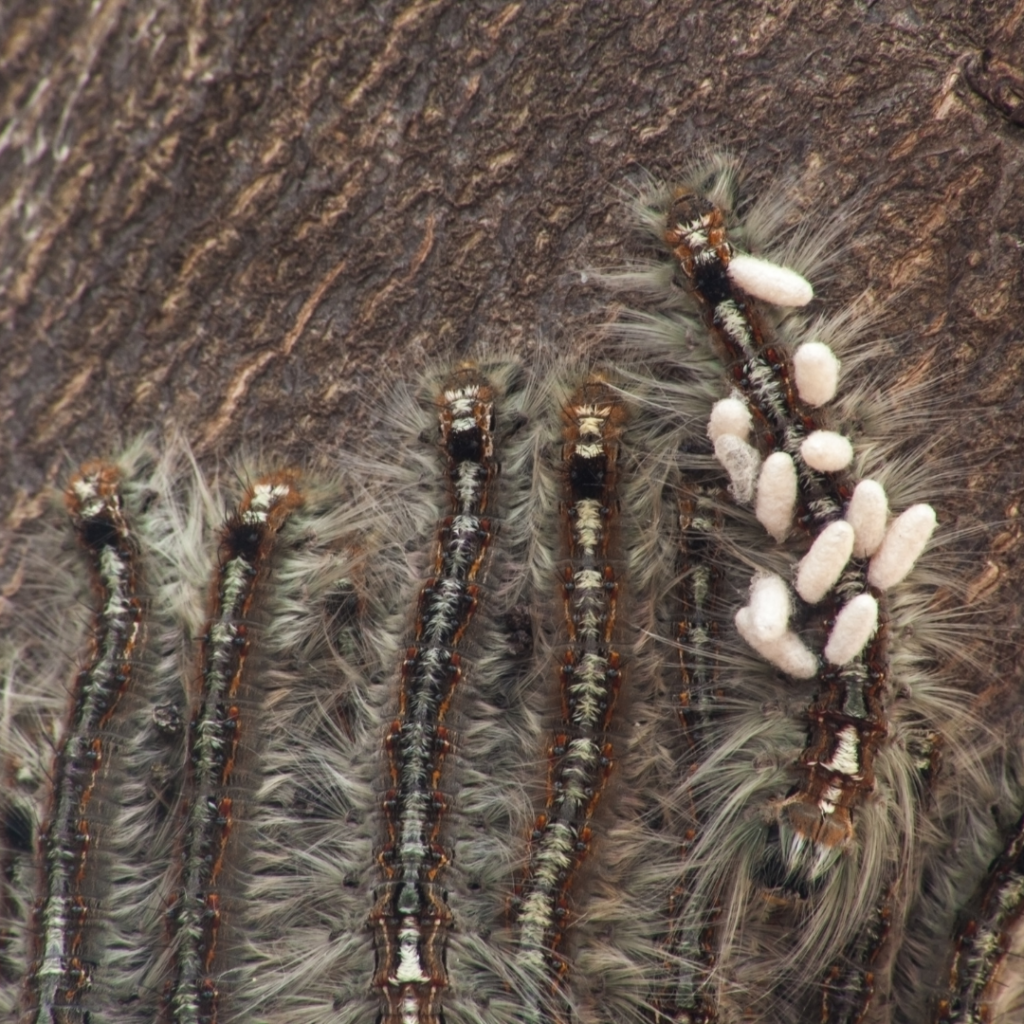
Even though they look adorable and harmless, these caterpillars are destructive to Ficus trees.
Quick Facts
| Scientific Name | Horama edwardsii |
| Other Names | Edwards\’ wasp moth caterpillar |
| Length (cm/inches) | Up to 4 cm / 1.5 inches |
| Width (cm/inches) | 1-2 cm (0.4-0.8 inches) |
| Habitat/Food Sources | Found in North and Central America |
| Distribution | Found in North and Central America, from Canada to Mexico |
| Dangerous or Not? | Not dangerous to humans or animals. |
| Pest Status & Damage | They are a natural predator of other pest insects. |
Description & Identification Guide
These caterpillars can defoliate tree leaves when their numbers are high, potentially even killing trees. Ficus trees in Florida are often considerably impacted by Edwards\’ Wasp moth caterpillar. And even though they appear white, when fully grown, the caterpillars are pale yellow with a reddish/orange and white head and four white stripes on the back.
The caterpillars feed on leaf margins or create irregular holes in the leaves. Once they reach their full size, they pupate for a few weeks and emerge as moth wasps.
Final Thoughts
There you have it! A list of some of the most adorable white caterpillars in the US.
And even though these caterpillars look harmless and do not actively attack pets and people, it is better to keep your distance unless you are sure about their safety. Some of these cute creatures hide venomous stings under their fluffy white coats.
Even brushing against their hair is sometimes more than enough to trigger an allergic reaction in people. So, keep your distance and know your caterpillars!
Frequently Asked Questions
Is there such a thing as a white caterpillar?
There are several different white caterpillars, all with unique identifying traits. Primarily, they are the larvae of various moth and butterfly species. However, some wasps also have white larvae that look like caterpillars. The domestic silk moth caterpillar is also white.
What is the most common caterpillar?
The painted lady butterfly is likely the most common butterfly caterpillar in the world. It is found on nearly every continent. However, some people argue that armyworms are the most common caterpillars, and still others give this credit to cabbageworm caterpillars.
Can a caterpillar give you a rash?
Many caterpillars have hairs or spines which are connected to venomous glands. These tiny hairs are called setae, and they are what can cause a rash. Depending on the species and individual, reactions range from mildly itchy to moderately extreme inflammation.
How do you treat hairy caterpillar rash at home?
To treat a rash caused by caterpillar stings, you can use ice packs, analgesics, creams, antihistamines, and lotions with steroids. They reduce inflammation in no time. However, if there is a severe allergic reaction, you should immediately seek medical help.
What caterpillar turns into a white butterfly?
The Imported Cabbage worm, also known as the white cabbage caterpillar, turns into a white butterfly. They feed on cabbages and other plants found in vegetable gardens.
Do you know of other variety of white caterpillars? Let us know in the comment section below. Also, check out our other articles:
Potato Bug 101: Potato bug bites! And everything else that you’d like to know!
All About Worm Castings and Their Benefits to Plants & Soil!
10+ Natural Pest Control for Houseplants to Protect Them from Insects and Diseases







